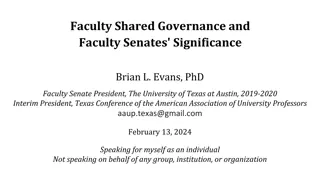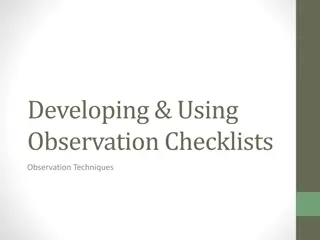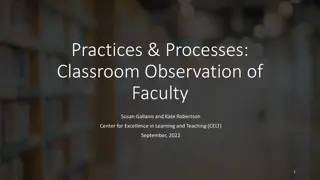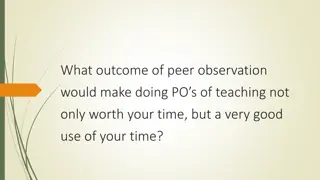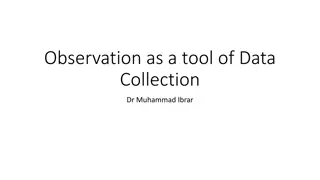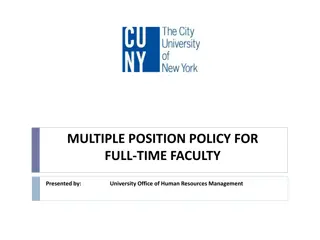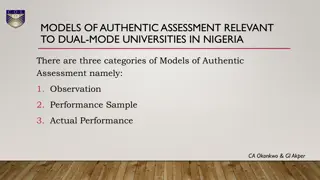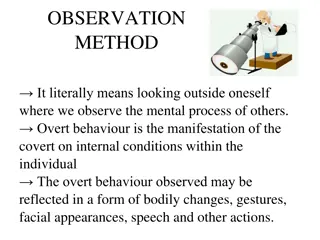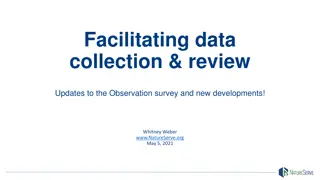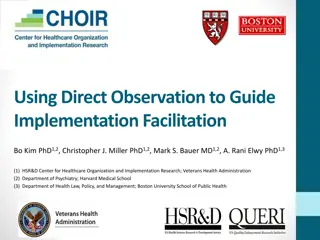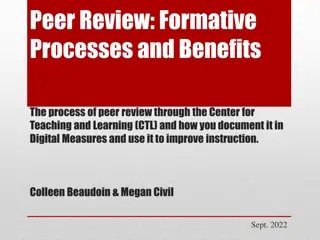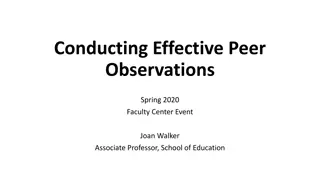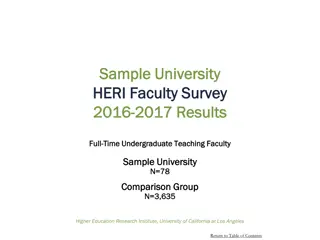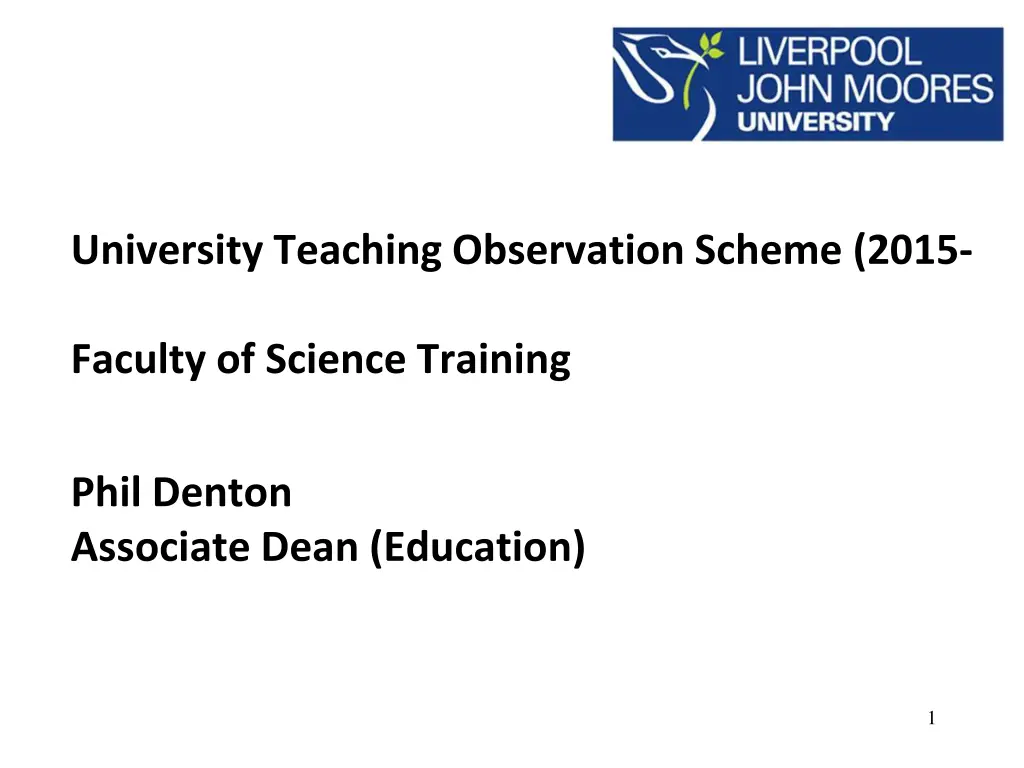
Teaching Observation Scheme Process in University
Explore the detailed process of the Teaching Observation Scheme at a university, including pre-observation meetings, observation guidelines, and post-observation discussions. This scheme aims to enhance teaching quality through reflective practices and constructive feedback within a supportive environment.
Download Presentation

Please find below an Image/Link to download the presentation.
The content on the website is provided AS IS for your information and personal use only. It may not be sold, licensed, or shared on other websites without obtaining consent from the author. If you encounter any issues during the download, it is possible that the publisher has removed the file from their server.
You are allowed to download the files provided on this website for personal or commercial use, subject to the condition that they are used lawfully. All files are the property of their respective owners.
The content on the website is provided AS IS for your information and personal use only. It may not be sold, licensed, or shared on other websites without obtaining consent from the author.
E N D
Presentation Transcript
University Teaching Observation Scheme (2015- Faculty of Science Training Phil Denton Associate Dean (Education) 1
Aims of this session To provide information on the LJMU teaching observation scheme and associated processes. To discuss the Faculty s observation criteria to ensure consistency in their application. To consider classroom-relevant legislation. To review some recommended practices in giving supportive feedback. To confirm reporting arrangements (Form A and B). . before we continue, let s introduce ourselves. 2
Background to the Scheme The new teaching observation scheme replaces both the direct observation and peer review schemes. It is aligned with the new QAA Code for HE: Expectation B3.3 Qualified and Professional Staff. The purpose of the revised Teaching Observation Scheme is to enable academic staff to gain feedback from a trained and experienced observer as part of a process of reflection on teaching performance with an increased emphasis on the intention to engage academics in critical discussion about learning and teaching. 3
Background to the Scheme Objectives To provide an opportunity for staff to reflect on their practice. To identify and disseminate good practice. To engage academic staff in self-reflection and critical discourse. To link staff development support to strategic improvements in teaching and learning. To promote the scholarship of teaching and learning. To provide evidence of LJMU s commitment to improving the quality of learning opportunities. Underlying Principle: Teaching observation is a confidential, developmental process that takes places within a supportive environment and, as such, you cannot fail a teaching observation. 4
Process for observers Pre-observation meeting You should contact your identified observee from the list circulated by your Directorat the start of each semester: Forward the Faculty Teaching Observation Form (Form A) to the observee and agree a suitable teaching session to observe. You should observe a session where the observee is engaged with the class throughout the entire session e.g. lecture, workshop. Arrange a pre-observation meeting: To discuss the intended outcomes of the observed session. To agree a focus of the observation. To review associated resources or strategies, where relevant. To clarify the observation criteria with the observee. To agree a time, date, venue for post-observation meeting. 5
Process for observers Observation Arrive 5 minutes before start of the observed session. It is better to sit at the rear so that you can observe the full class and properly assess audibility and visual aids. You may or may not be introduced by the observee. Positively acknowledge the observee at the end of the session. The post-observation meeting will be at another time in order that Part 2 of Form A may be completed. 6
Process for observers Post-observation meeting Arranged by the observer and normally within 2 weeks of the observation. Discuss the observee s written reflections on the session, recorded on Part 2 of the Faculty Observation Form, Form A. Before, during, or after the meeting: Consider the observee s reflections and write down your response and observations of the session on Form A. Complete the Observation Summary Form (Form B): Note any issues that adversely affected the session that were outside the control of the observee. Note any good practice for wider dissemination. Forms considered in detail later. 7
For discussion Faculty Observation Criteria These criteria are aligned with the UK Professional Standards Framework: Delivery: The tutor s presentation of the taught material. Inclusivity: How the tutor and teaching materials ensured that the whole class were included. Structure: Organisation of material and contextualisation by the tutor. Content: The quality and appropriateness of the presented material. Other: Other ways in which the tutor ensured a smooth, comfortable and safe session. These prompts help to frame feedback remarks before the final question on Form A, Overall, were students engaged during this session? In groups of 2-4, consider the questions that you would ask yourself to determine if good practice was demonstratedwith respect to DISCO. 8
Delivery (tutor) Did the tutor face the group and maintain good eye contact? Was the tutor s non-verbal behaviour and positioning in room appropriate? Were materials presented at an appropriate pace? Was oral delivery of appropriate volume and clarity? Did the tutor seem to be enthusiastic and confident with the material? Did the delivery stimulate interest among learners? Were appropriate teaching methods used to promote learning? Was the tutor able to establish a rapport with the group e.g. were students' names used? Were any novel learning technologies used to enhance delivery? 9
Inclusivity (tutor, materials) Did the tutor respond appropriately to the dynamics of the whole group e.g. going over material again were class appear unsure? Were opportunities provided for assessment or interaction? Was students input valued? Were differences of opinion handled sensitively? Did written information conform to Disability Discrimination Act (DDA) requirements? Did the tutor repeat individual responses as appropriate so the whole group can hear? Was the tutor's choice of words inclusive? For group work activities, were all group members involved? For student-centred learning activities, were different types of resources provided to reflect different learner styles? Was the session 'internationalised'? 10
Structure (tutor, materials) Was there an appropriate introduction? Were the materials presented in a logical sequence? Were links made between this session and past/future sessions? Were the key points emphasised? Was there a summary at the end of the session? Were there opportunities for short breaks during the sesison? 11
Content (materials) Were the content and intended outcomes suitable for the level of study? Were real-world examples used to support and enhance learning? Were slides clear and well-composed? Were diagrams and photographs used? Was the academic language used appropriate for the level of study? Was material up-to-date and referenced as apt? Did material provide evidence of scholarly/research activity? Was 'non-traditional' subject content used in an effective manner? 12
Other (tutor) Did the tutor arrive in good time? Did the tutor appear to have prepared for the session? Did the tutor show competence with the audio-visual resources? Did the tutor organise seating appropriately? Did the tutor ensures that the environment was appropriate in terms of light, sound (including extraneous noise) and temperature? Did the tutor prepare sufficient resources (e.g. printed notes)? Did the tutor maintain class discipline? Did the tutor ensure a safe environment? 13
Overall, were students engaged during this session? This question arose during discussions of the criteria with Faculty staff and was acknowledged as being of fundamental importance. It recognises that a taught session is not simply the sum of its parts: For example, a charismatic lecturer might negate the need for high quality slides. The five observation criteria act as useful prompts because, although they need not be demonstrated in full, any significant deficiency in any of them would impair potential engagement e.g. Inaudible delivery. Only acknowledging the front row of a class. Not getting across the aims or purpose of the session. Too-small font size on slides. Not dealing with intrusive, extraneous noise. 14
The Disability Discrimination Act 1995 (DDA) This places a duty on LJMU to make 'reasonable adjustments' for disabled staff and students, and to be proactive. For teaching materials in class, the general advice is: Use black-on-white and/or high contrast colours. Adopt simple layouts e.g. avoid text on top of imagery. Favour sans serif fonts such as Arial or Calibri. Avoid italics and block capitals. Align text to the left and avoid using justified text For printed materials, use font size 12 as a minimum and avoid glossy or patterned paper. Moni Akinsanya, Equality Adviser, M.M.Akinsanya@ljmu.ac.uk 15
Safety of Students: SPC13 Academic staff will generally be responsible for supervision of students carrying out work set or directed by the academic staff on University premises This will include under emergency conditions, e.g. evacuating classes which they are teaching during fire alarm activations. Consequently, there will a reasonable expectation that tutors: Ensure fire exits and passageways are clear. Check that all students are seated and capacity is not exceeded. Safety Code of Practice 13: https://www2.ljmu.ac.uk/HSU/65144.htm A reminder that the observation is completely confidential, although a third party would need to be informed if there was a deviation from legally-obliged behaviour that the tutor was unwilling to change e.g. locking the classroom door to prevent latecomers entering. 16
Guidance for supportive feedback (Feedback forms are circulated during training for consideration). Invite the observee to reflect on how the session went and to elaborate on their written comments on Form A. Identify the positives in what you observed: Example Make comments in the context of the observations you made. Refer to additional sources of evidence in support of comments e.g. generic NSS/module appraisal remarks. Make suggestions based on your practice or that of colleagues. You are (probably) not the observee s line manager, however, if the observee is receptive or enquires about development, a reminder LJMU offers Presentation Skills training (1 days). In similar circumstances, permissible also to suggest that the observee arranges an informal observation of a colleague who is agreeable. 17
Forms and reporting arrangements Form A to be signed by both parties after post-observation meeting. Digital signatures are acceptable. Signed Form A is retained by observee and may be used in PDPR. Form B is completed and signed by the observer, after discussion with the observee, and forwarded to the Associate Dean (Education). The Associate Dean (Education) acts on information provided in Form B e.g. queries to estates or AV, organising of general staff development events. 18
Summary Each year, Science staff will either act as observer, or be observed by a trained and experienced member of staff. The process consists of: pre-observation meeting, observation, post-observation meeting. Completed Faculty Teaching Observation form (Form A) is agreed, signed, and retained by the observee. Completed Observation Summary form (Form B) is agreed, signed and forwarded to Associate Dean (Education). I will email you with links to these slides, electronic copies of finalised forms A and B, and a (very) short evaluation survey. 19

